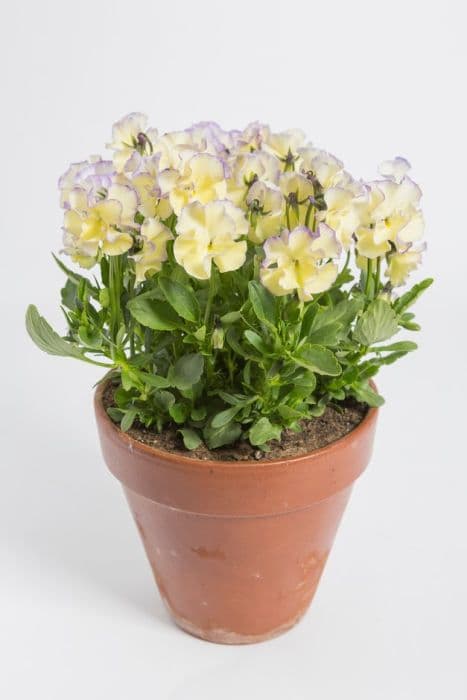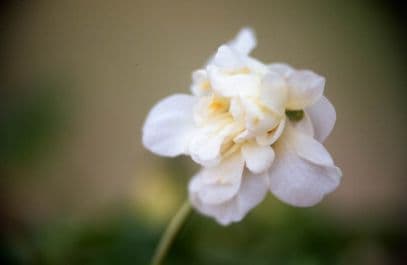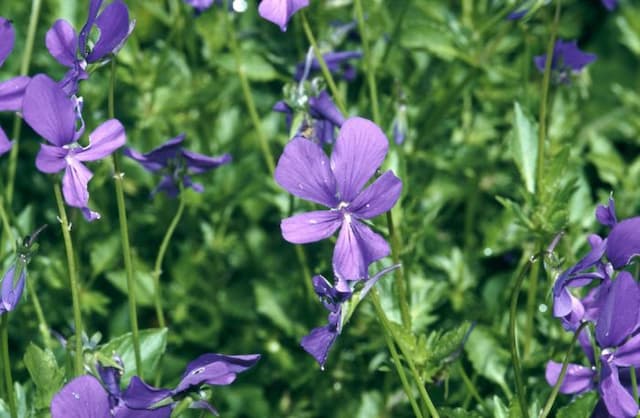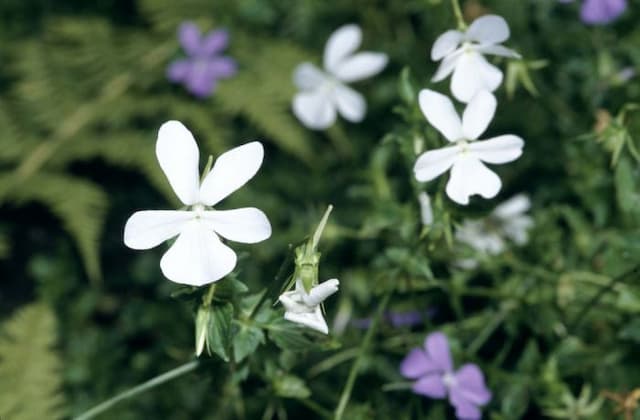Pansy Viola 'Clementina' (Va)

ABOUT
Viola 'Clementina' is a charming variety of viola that features a captivating display of flowers. The blossoms of this plant are unique, with a rich blend of colors that can include shades of lavender, purple, yellow, and cream. Often, the flowers have a delightful pattern with a darker center, known as a "face," which is framed by the brighter colors of the petals' edges. The foliage of Viola 'Clementina' is lush and green, providing a lovely backdrop to the colorful flowers. The leaves are typically heart-shaped or rounded, with slight serrations at the margins, giving them a soft, textured appearance. The plant forms a low mound or tuft, with the leaves close to the ground and the flowers rising just above the greenery. Viola 'Clementina' tends to bloom profusely over a long period. The petals are velvety and may have fine lines radiating from the center towards the edges, which guide pollinators to the nectar and pollen. The flowers have five petals, generally with the lower petal slightly larger and the upper petals overlapping a bit to form a characteristic viola shape. Overall, Viola 'Clementina' is a delightful addition to any garden or container, bringing a splash of color and whimsy with its endearing and colorful blooms set against a verdant bed of foliage.
About this plant
 Names
NamesFamily
Violaceae
Synonyms
Clementine Violet
Common names
Viola 'Clementina'
 Toxicity
ToxicityTo humans
The plant commonly known as pansy is not considered particularly toxic to humans. In general, pansies are often grown for ornamental purposes, and some parts of certain varieties are even edible and used in culinary applications, like garnishing salads and desserts. However, ingestion of large quantities or parts of certain varieties that are not meant for consumption could potentially cause mild gastrointestinal upset due to the presence of saponins and other compounds. It is not common for pansies to cause severe poisoning in humans when touched or ingested in small amounts.
To pets
The plant commonly known as pansy is generally not considered toxic to pets. Pansies are often safe for pets to be around, and there are no major toxicity concerns for dogs and cats. While they are not specifically known to be poisonous, it's always possible that an individual pet could have a sensitivity or allergic reaction, or could experience mild stomach upset if they consume a large amount of the plant. If any signs of illness are observed after ingestion, it is advisable to consult a veterinarian.
 Characteristics
CharacteristicsLife cycle
Perennials
Foliage type
Evergreen
Color of leaves
Green
Flower color
Mixed
Height
0.5 feet (15 cm)
Spread
1 feet (30 cm)
Plant type
Herb
Hardiness zones
Varies
Native area
Europe
Benefits
 General Benefits
General Benefits- Aesthetic Appeal: Viola 'Clementina', commonly known as Pansy, adds vibrant colors and beauty to gardens and landscapes with its unique and varied flower patterns.
- Attracts Pollinators: Pansies attract bees, butterflies, and other beneficial insects, which helps pollinate other plants in the garden.
- Edible Flowers: The flowers of some Pansy varieties, including Viola 'Clementina', are edible and can be used to garnish salads, desserts, and drinks.
- Easy to Grow: Pansies are relatively low-maintenance and can be easily grown in containers or flowerbeds, making them suitable for gardeners of all skill levels.
- Seasonal Flexibility: As cool-weather plants, Pansies can tolerate frost and are ideal for providing color in the garden during the fall and spring months.
- Companion Planting: Pansies make excellent companion plants for spring bulbs and other cool-season flowers, helping to create full and balanced garden displays.
 Medical Properties
Medical PropertiesThis plant is not used for medical purposes.
 Air-purifying Qualities
Air-purifying QualitiesThis plant is not specifically known for air purifying qualities.
 Other Uses
Other Uses- Natural dyes: The petals of the pansy can be used to create natural dyes for fabric, offering hues ranging from yellow to green, depending on the mordant used.
- Garnishing: Pansy flowers can add a splash of color to salads or desserts when used as an edible garnish.
- Crafting: The flowers can be pressed and included in various craft projects, such as handmade paper, bookmaking, or scrapbooking to add natural beauty and a floral aspect.
- Ice cubes: Freeze pansy blooms in ice cubes for an added floral touch in drinks, perfect for special occasions or garden parties.
- Floral syrups: Create a pansy-infused simple syrup to add a unique and subtle floral flavor to cocktails, sodas, and desserts.
- Perfumery: Though not as common as other flowers, pansy petals can be used in creating floral waters or simple perfumes.
- Photography: The striking colors of pansy flowers can serve as a vibrant subject for macro photography or as photographic props.
- Sachets: Dried pansy flowers can be included in sachets to provide a light, natural scent to drawers and closets.
- Decoupage: Incorporate pansy flowers into decoupage projects to add natural elements to furniture, trays, or decorative objects.
- Seed art: The seeds of the pansy can be included in seed art creations, which is a craft that uses seeds and their natural colors to create mosaics or other artistic designs.
Interesting Facts
 Feng Shui
Feng ShuiThe plant commonly known as pansy is not used in Feng Shui practice.
 Zodiac Sign Compitability
Zodiac Sign CompitabilityThe pansy is not used in astrology practice.
 Plant Symbolism
Plant Symbolism- Innocence: Violas often represent innocence due to their delicate, unassuming flowers.
- Spiritual Wisdom: Traditionally, violas have symbolized the idea of spiritual wisdom, possibly due to their three petals which some associate with the Holy Trinity.
- Modesty: With their small stature and simple beauty, violas are often connected to the values of modesty and humility.
- Love: As with many flowers, violas can also represent love, particularly a tender and faithful love.
- Remembrance: It is also common for violas to be associated with remembrance, making them a thoughtful plant for commemorating significant individuals or events.
 Water
WaterPansies, including the variety Viola 'Clementina', prefer consistent moisture. They should be watered when the top inch of soil feels dry to the touch. Depending on weather conditions, this might be approximately once every week, but it's crucial to check the soil moisture level rather than adhere to a strict schedule. Provide pansies with about one gallon of water per plant to ensure deep watering that reaches the roots. During hot or dry periods, additional watering may be necessary to keep the soil consistently moist.
 Light
LightPansies, such as Viola 'Clementina', thrive in full to partial sunlight. They will do best in a location that receives at least 6 hours of direct sunlight each day. Filtered sunlight or afternoon shade can help protect the flowers from extreme heat, particularly in warmer climates.
 Temperature
TemperaturePansies, including Viola 'Clementina', enjoy cool temperatures and can tolerate a light frost. They can survive in temperatures as low as 20 degrees Fahrenheit and as high as 80 degrees Fahrenheit. The ideal temperature range for pansies is between 40 and 60 degrees Fahrenheit, where they tend to flourish the most.
 Pruning
PruningPansies such as Viola 'Clementina' should be deadheaded regularly to remove spent blooms and encourage more flowers. Light pruning can be done throughout the blooming season to maintain a neat appearance and promote new growth. The best time for pruning is in the late afternoon or on overcast days to minimize stress on the plants.
 Cleaning
CleaningAs needed
 Soil
SoilPansies like Viola 'Clementina' prefer well-draining soil rich in organic matter with a slightly acidic to neutral pH of 6.0 to 7.0. A good mix for pansies would be one-third peat moss, one-third garden loam, and one-third vermiculite or perlite to ensure proper drainage and aeration.
 Repotting
RepottingPansies such as Viola 'Clementina' generally do not require frequent repotting and can be done every 1-2 years. It's best done in the spring or fall when the plant is not in peak bloom.
 Humidity & Misting
Humidity & MistingPansies, including Viola 'Clementina', prefer average to slightly above average humidity levels but are generally tolerant of a wide range of conditions as long as they are not in extremely dry air.
 Suitable locations
Suitable locationsIndoor
Place in bright, indirect light; avoid overwatering.
Outdoor
Full sun to partial shade; protect from harsh winds.
Hardiness zone
4-8 USDA
 Life cycle
Life cycle'Clementina' Violet (Viola 'Clementina') begins its life cycle as a seed, which upon germination in favorable conditions of moisture and light, develops into a small seedling. The seedling quickly forms a rosette of leaves at the soil surface and develops roots. As the plant matures, it grows larger and produces heart-shaped, often variegated leaves, characteristic of the Viola genus. In its flowering stage, 'Clementina' Violet produces distinctive, fragrant flowers that are usually bicolored with a combination of purple, lavender, and yellow hues, typically in the spring and sometimes again in the fall. After pollination, the flowers develop into capsules that split open when mature to disperse seeds, completing the reproduction cycle. Though perennials, 'Clementina' Violets may be treated as annuals or biennials in some climates and require a period of cold stratification to trigger subsequent blooms in future seasons.
 Propogation
PropogationPropogation time
Spring-summer
The most popular method of propagation for the Viola 'Clementina'—often referred to as pansy—is through seed sowing. The preferred time to sow pansy seeds is late winter to spring, ensuring that the soil temperature is cool enough to facilitate germination. Seeds should be sown thinly onto the surface of a well-drained seed starting mix and lightly covered with soil. The pots or flats used for sowing should then be placed in a location that maintains a consistent temperature of about 65 degrees Fahrenheit (approximately 18 degrees Celsius), which is optimal for germination. Germination usually takes about 14 to 21 days. Once the seedlings have developed their first true leaves, they can be transplanted into individual pots and grown on until they are ready to be moved outdoors.









